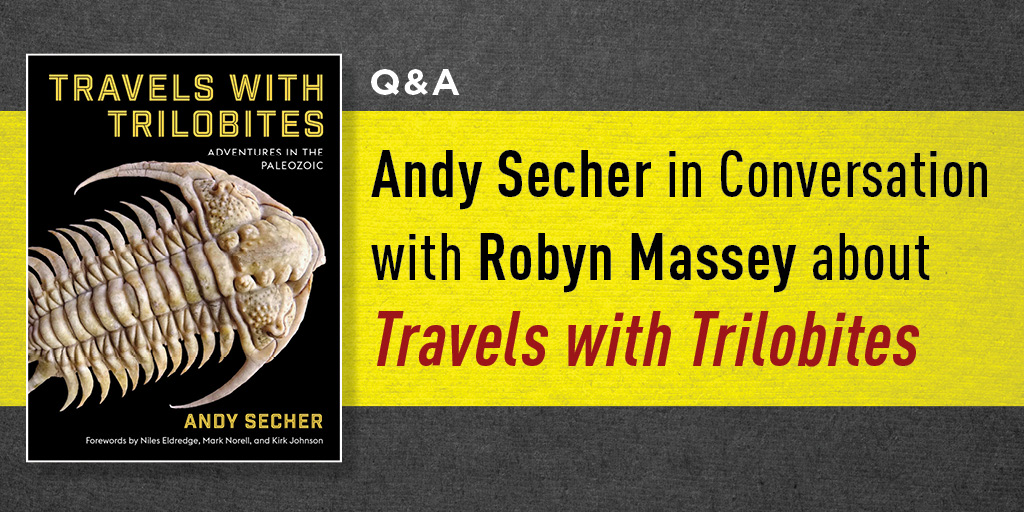Andy Secher in Conversation with Robyn Massey about Travels with Trilobites

For thirty years before delving more fully into the Paleozoic world of trilobites, Andy Secher was a key behind-the-scenes figure in the rock and roll industry. He was not only the long-time editor of the popular and influential hard rock magazine, Hit Parader, but also the president of Titanium Records, a label distributed through the Time-Warner music machine. Perhaps that time in his life is best reflected by his name being prominently (and humorously) mentioned in the Guns N’ Roses song “Get in the Ring.” After his three-decade sojourn through the rock and roll jungle, Secher turned his full attention toward another paramount interest: trilobites. Indeed, he often says that, at a certain point in life, his focus shifted from rock to rocks! Secher has put together one of the most impressive and extensive trilobite collections in the world. It is an arthropod assemblage that features thousands of complete specimens that range in age from the Lower Cambrian to the Upper Permian, a span that covers over 250 million years of Earth history.
Secher is the author of Travel with Trilobites: Adventures in the Paleozoic. He also writes and edits the popular trilobite website for the American Museum of Natural History, where photos of over a thousand of his specimens are featured. Since 2011 he has been a field associate in paleontology with the AMNH, and he continues to expand his interest in trilobites by traveling the globe (so long as a trip doesn’t conflict with a New York Giants football game) to meet with fellow enthusiasts, visit legendary museums, attend leading fossil shows, and explore major digging localities. He has chronicled many of these fossil-inspired adventures in a series of magazine articles and internet features, some of which have served as the inspiration for Travels with Trilobites.
Robyn Massey: What exactly is a trilobite?
Andy Secher: Trilobites were among the first dominant life-forms to inhabit our planet’s primal seas. They were arthropods that first emerged in the Lower Cambrian, some 521 million years ago, and survived until the end of the Permian, 270 million years later. They were equipped with calcite-covered bodies that were divided into three parts: a head (or cephalon), a midsection (or thorax), and a tail (or pygidium). Not to get overly scientific, but the name “trilobite” actually derives from the three sections—or “lobes”—that divided their bodies laterally. They could also grow to more than two feet in length, though most species were only three or four inches long.
But what makes them particularly interesting to both academics and collectors is that they were a primary component of the famed Cambrian Explosion, which started approximately 540 million years ago. That’s when the early oceans first began bursting with life. Some 20 million years later—which is a mere “blip” in geologic time—trilobites dominated those seas. By that time, they already possessed not only hard outer shells, but also complex eyes, powerful walking legs, and a primitive but well-developed reproductive system. They were perhaps the first animals ever to display some of these revolutionary morphological traits, all of which helped them become the rulers of those ancient oceans. In fact, it’s their calcite outer shells which have made their fossilized remains so prevalent throughout sedimentary layers around the globe.
Massey: How many species of trilobites were there?
Secher: Believe it or not, more than 25,000 different trilobite species have been scientifically recognized so far, but I tend to believe that many times that number actually emerged during their half-billion-year trek through evolutionary time. A significant percentage of those species appeared soon after trilobites first evolved in the Cambrian. During that period, thousands of different species were filling virtually every available marine niche, inhabiting the various tidal basins, off-shore plateaus, and continental shelves that then existed. Some even appear to have been blind, deep-sea dwellers. Of course, the planet was a very different place back during the Paleozoic Era, and the continental masses that we today so easily recognize by their shape and global alignment were then located in radically different corners of the planet. The fact is that trilobite diversity peaked soon after their emergence in those Cambrian seas. By the Ordovician, they had already begun to face a variety of environmental challenges, including a growing number of predators who basically viewed trilobites as little more than sushi in a shell. By the time they reached the end of the line in the Permian, perhaps only a hundred trilobite species remained, all members of one order, the proetids.
Massey: Where are trilobite fossils found?
Secher: The large range of trilobite fossils is a major part of their appeal. Trilobite fossils have been found on every continent on Earth—from Australia’s Kangaroo Island, to Canada’s Anticosti Island, and just about every place in between. Some of the most famous locations (which are all addressed within the pages of Travels with Trilobites) are in China, Morocco, Russia, and the United States. You can travel to the wilds of Greenland or the heart of Scotland and uncover trilobites. . . though in no way does that mean they’re easy to find or that their discoveries are common occurrences. You need to know just where to look and then be prepared to undertake some serious, hand-blistering field work once you get there.
Massey: You earlier mentioned that a trilobite’s hard outer shell is what becomes fossilized. Do the actual animals ever get preserved in the fossilization process?
Secher: Soft part preservation is one of the rarest finds in the fossil record when it comes to trilobites. There are certain sites—such as the Burgess Shale in Western Canada, the Chengjiang Formation of Southern China, and the Beecher Beds in upstate New York—where trilobite limbs, antennae, and, in exceedingly rare cases, even trilobite eggs have been preserved. Many of these discoveries have only occurred in recent years, especially as the fossil preparation process has reached new levels of skill and artistry.
Massey: Were trilobites strictly marine creatures?
Secher: Yes, trilobites only lived in the seas, though there has been some recent scientific evidence indicating that even early in their development in the Lower Cambrian, certain species may have ventured for very short periods onto surrounding beach perimeters either in search of food or possibly as part of a mating ritual, much like we still see today with horseshoe crabs. Thus, they may have been the very first creatures in the history of our world to wander out of the seas and onto land, albeit briefly.
Massey: That mention of horseshoe crabs begs the question as to whether trilobites have any living descendants?
Secher: While they may have shared certain lifestyle characteristics with modern arthropods—and indeed, may have initiated many of those behavioral patterns—it can be definitively stated that while certain contemporary arthropods, including horseshoe crabs, isopods, and lobsters, may bear a superficial resemblance to some trilobites, none are directly related. Quite simply, when the trilobite line came to its dramatic conclusion at the end of the Permian, it left behind no direct descendants.
Massey: What do you find so intriguing about trilobites?
Secher: Trilobites have fascinated me since I was a little kid. I don’t know why—and I’ve given it a lot of thought over the years. I can certainly give you the standard answer: how trilobites were one of the most important and abundant inhabitants of early Earth, and how the fossils of so many unknown trilobite species are still lurking out there somewhere, just waiting for someone to break them out of their eons-old rock encasements. Then you have to consider their incredible antiquity, and that they represent one of the planet’s first successful experiments with complex organic matter.
But the fact is that, for whatever reason, I just find them fascinating. Perhaps my most basic response is that they crank my imagination into overdrive; they ignite wonderful, though occasionally bizarre, thoughts every time I look at them. They’re amazing remnants of the primeval past, and no other creature has ever displayed either the diversity or longevity of these unique examples of Paleozoic life.
Massey: What prompted you to write Travels with Trilobites?
Secher: I was in the music industry for many years. One of the benefits of that lifestyle was the opportunity to travel all over the world. Often, I would go to see a band perform in a location—whether it was Paris, Tokyo, or Toronto—where I knew there was a major trilobite collection, a noted fossil-oriented museum, or a legendary Paleozoic site that I wanted to visit. Once I was home, I would occasionally write about my trip (at least the trilobite side of things) for one of the various natural history magazines that existed at the time. Before I knew it, I had about a dozen of those stories. Some of them I subsequently used on the trilobite website of the American Museum of Natural History, which I’ve edited since 2011. At some indeterminate point a few years ago, the idea struck me to expand upon that basic concept and create a book that features not only my various travel stories, but also large, color photos of some of the amazing specimens I’ve been able to acquire.
Massey: How many trilobites do you have in your collection?
Secher: I’m too busy collecting to count ’em! I would guess somewhere around 5,000 complete specimens which includes over 4,000 distinct species. That’s the trick—a serious collector wants as many complete, unique specimens as they can acquire. When it comes to trilobites, quality counts just as much as mere quantity. And as it happens, just when you think you’ve got ’em all, a new location will open up in some distant land, and the hunt begins all over again.
Massey: We must ask, what killed off the trilobites?
Secher: It was probably not something as dramatic as what killed off the dinosaurs, though it may have been close. Trilobites were in a slow, steady decline virtually from the moment they entered the Paleozoic seas. There were a series of major natural disasters at the end of the Cambrian, Ordovician, and Devonian, each of which further weakened the trilobite line. By the time the Carboniferous Period began, only one order of trilobites remained. In dramatic contrast, at their peak there were ten different orders. Then the greatest natural disaster in Earth’s history occurred at the end of the Permian—possibly triggered by a series of volcanic eruptions? in what is now Siberia—which wiped out the remaining trilobites, along with 90 percent of life on the planet.
Massey: Finally, would someone not particularly knowledgeable about trilobites find Travels with Trilobites an interesting read?
Secher: Perhaps I’m a bit biased, but of course they would! I’m not a scientist, nor do I pretend to be one. What I tried to present was a compelling tale filled with pure Paleozoic infotainment. While there are plenty of scientifically challenging topics discussed throughout the book, my primary objective was to convey the wonder of trilobites by telling their story, as well as the stories of those who collect them, research them, and dig for them in the field. It’s a tale that encompasses over half-a-billion years of Earth’s history. I think anyone who possesses a true sense of wonder, and enjoys reading about some of the most amazing creatures our planet has ever produced, will enjoy jumping aboard the trilobite train and traveling the world in search of these incredible invertebrates. And if you prefer, you can just initially skip the words and just look at all the pretty pictures!








